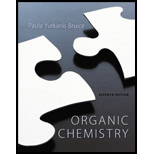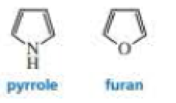
Organic Chemistry; Modified MasteringChemistry with Pearson eText -- ValuePack Access Card; Study Guide and Student Solutions Manual for Organic Chemistry, Books a la Carte Edition (7th Edition)
7th Edition
ISBN: 9780134240152
Author: Paula Yurkanis Bruice
Publisher: PEARSON
expand_more
expand_more
format_list_bulleted
Concept explainers
Textbook Question
Chapter 8, Problem 81P
Why is the delocalization energy of pyrrole (21 kcal/mol) greater than that of furan (16 kcal/mol)?

Expert Solution & Answer
Want to see the full answer?
Check out a sample textbook solution
Students have asked these similar questions
If a mixture has an ee of 90%, what is the percentage of each enantiomer?
Multiple Choice
80% : 20%
55% : 45%
95% : 5%
65% : 35%
1.
The AHhyd of (E)-2,2,5,5-tetramethylhex-3-ene is -26.9 kcal/mol while the Z-
isomer has a AHhyd of -36.2 kcal/mol. Identify which structure is the E-isomer and
which is the Z-isomer. Which isomer is more stable? How much more stable? Why
is that isomer more stable?
xx
Cyclic forms of D-glucose: Furanose and Pyranose
Recall that aldehyde and alcohol react to form hemiacetal. The O in OH acts as nucleophile, attacking
the partially positive C of C=O. The H from the OH of alcohol is transferred to the O of C=O.
он
R
R1
HO,
On the other hand, ketone and alcohol also react to form hemiketal.
OH
R
R2
R
R1
HO,
In glucose the OH in C-4 or C-5 can react with the C=O. If the C-4 OH reacts with the C=O the
structure is a furanose (5-membered ring); if C-5 OH the product is a pyranose (6-membered ring).
Furanose and pyranose are derived from cyclic ethers furan and pyran. Both furanose and pyranose have
two isomers: the alpha and beta (also called anomers).
Furan
Pyran
Furanose and pyranose form of D-glucose (note the numbering of carbon atoms)
Furanose (5-membered ring)
Alpha
Pyranose (6-membered ring)
Alpha
Beta
Beta
1
HO-
Но
H-
Но
H-
_2
FH-
H-
OH
FHO-
H
HO.
но-
H-
но-
H.
Но
Но
H-4
H_5.
FHO-
FHO-
H
OH
6CH2OH
H
CH,OH
CH,OH
CH2OH
C-1 OH is on the right
Alpha-D-…
Chapter 8 Solutions
Organic Chemistry; Modified MasteringChemistry with Pearson eText -- ValuePack Access Card; Study Guide and Student Solutions Manual for Organic Chemistry, Books a la Carte Edition (7th Edition)
Ch. 8.1 - Prob. 1PCh. 8.1 - Prob. 2PCh. 8.4 - Prob. 3PCh. 8.5 - Prob. 5PCh. 8.6 - a. Predict the relative bond lengths of the three...Ch. 8.6 - Prob. 7PCh. 8.6 - Prob. 8PCh. 8.8 - Prob. 9PCh. 8.9 - Prob. 10PCh. 8.9 - Prob. 12P
Ch. 8.9 - Prob. 13PCh. 8.10 - Prob. 14PCh. 8.10 - What orbitals contain the electrons represented as...Ch. 8.10 - Prob. 16PCh. 8.10 - Prob. 17PCh. 8.11 - Prob. 18PCh. 8.11 - Prob. 19PCh. 8.11 - Prob. 20PCh. 8.12 - Prob. 21PCh. 8.12 - Prob. 22PCh. 8.12 - Prob. 23PCh. 8.13 - Prob. 24PCh. 8.13 - Prob. 25PCh. 8.13 - Prob. 26PCh. 8.14 - Prob. 27PCh. 8.14 - Prob. 28PCh. 8.14 - Prob. 29PCh. 8.15 - Which member of each pair is the stronger acid?Ch. 8.15 - Which member of each pair is the stronger base? a....Ch. 8.15 - Rank the following compounds from strongest acid...Ch. 8.15 - Prob. 34PCh. 8.16 - Prob. 35PCh. 8.17 - Prob. 37PCh. 8.17 - Prob. 38PCh. 8.17 - Prob. 39PCh. 8.17 - Prob. 40PCh. 8.17 - Prob. 41PCh. 8.17 - Prob. 42PCh. 8.18 - Prob. 43PCh. 8.18 - Prob. 44PCh. 8.18 - Prob. 45PCh. 8.18 - Prob. 47PCh. 8.19 - Prob. 48PCh. 8.19 - Prob. 49PCh. 8.19 - Prob. 50PCh. 8.19 - Prob. 51PCh. 8.19 - Prob. 52PCh. 8.19 - Prob. 53PCh. 8.19 - Prob. 55PCh. 8.20 - Prob. 56PCh. 8 - Prob. 57PCh. 8 - Prob. 58PCh. 8 - Prob. 59PCh. 8 - Prob. 60PCh. 8 - Prob. 61PCh. 8 - Prob. 62PCh. 8 - Prob. 63PCh. 8 - Prob. 64PCh. 8 - Prob. 65PCh. 8 - Prob. 66PCh. 8 - Prob. 67PCh. 8 - Prob. 68PCh. 8 - Prob. 69PCh. 8 - Which compound is the strongest base?Ch. 8 - Prob. 71PCh. 8 - Prob. 72PCh. 8 - Prob. 73PCh. 8 - Prob. 74PCh. 8 - Prob. 75PCh. 8 - Prob. 76PCh. 8 - Prob. 77PCh. 8 - Prob. 78PCh. 8 - Purine is a heterocyclic compound with four...Ch. 8 - Prob. 80PCh. 8 - Why is the delocalization energy of pyrrole (21...Ch. 8 - Prob. 82PCh. 8 - Prob. 83PCh. 8 - Prob. 84PCh. 8 - A student obtained two products from the reaction...Ch. 8 - Prob. 86PCh. 8 - a. How could each of the following compounds be...Ch. 8 - Draw the products obtained from the reaction of...Ch. 8 - How would the following substituents affect the...Ch. 8 - Prob. 90PCh. 8 - The acid dissociation constant (Ka) for loss of a...Ch. 8 - Protonated cyclohexylamine has a Ka = 1 1011...Ch. 8 - Prob. 93PCh. 8 - Prob. 94PCh. 8 - Prob. 95PCh. 8 - Prob. 96PCh. 8 - Prob. 97PCh. 8 - a. Propose n mechanism for the following reaction:...Ch. 8 - Prob. 99PCh. 8 - As many as 18 different Diels-Alder products can...Ch. 8 - Prob. 101PCh. 8 - Prob. 102PCh. 8 - Prob. 103PCh. 8 - Prob. 104PCh. 8 - The experiment shown next and discussed in Section...Ch. 8 - Prob. 106PCh. 8 - Prob. 107PCh. 8 - Prob. 108PCh. 8 - Prob. 1PCh. 8 - Prob. 2PCh. 8 - Prob. 3PCh. 8 - Prob. 4PCh. 8 - Prob. 5PCh. 8 - Prob. 6PCh. 8 - Prob. 7PCh. 8 - Prob. 8PCh. 8 - Prob. 9PCh. 8 - Prob. 10PCh. 8 - Prob. 11PCh. 8 - Prob. 12P
Knowledge Booster
Learn more about
Need a deep-dive on the concept behind this application? Look no further. Learn more about this topic, chemistry and related others by exploring similar questions and additional content below.Similar questions
- Compare the reaction between 2,4,6-cycloheptatrienone and cyclopentadiene to the reaction between 2,4,6-cycloheptatrienone and ethene. Why does 2,4,6-cycloheptatrienone use two T electrons in one reaction and four T electrons in the other? a. b. + CH2=CH2arrow_forwardIsopulegol is formed as a single stereoisomer. Account for the fact that only a single stereoisomer is formedarrow_forward4-tert-butylcyclohexanolarrow_forward
- Draw a resonance structure, complete with all formal charges and lone (unshared) electron pairs, that shows the resonance interaction of the acetoxy with the para position in phenyl acetate. phenyl acetate ● CH3 • You do not have to consider stereochemistry. • Include all valence lone pairs in your answer. In cases where there is more than one answer, just draw one. Sn [F ?arrow_forwardOrganic chemistryarrow_forwardPlease don't provide handwriting solutionarrow_forward
- For the given ee values, calculate the percentage of each enantiomer present. Q: 90% eearrow_forwardIs C-O ester of 3-chloro-4’-methoxychalcone conjugated (talking about the H3CO attatched to the benzene ring)? Can you explain your answer?arrow_forwardWorksheet 4Saved v Design Layout References Mailings Review ViewHelp Acrobat Table Design Layout -11-A A Aa AEE-E 1 x x APA- 4. 3 49 E H Draw the mirror image, enantiomer, for each molecule. BB OH OH PH $ R 6 F CH₂OH H OH H H₂C % 5 OH T Prah G H CH3 OH COOH H A Search 6 OH Y Dec H 5 7 L Normal U 8 No Spacing 9 Styles PHB 1 Heading 1 0 home S end Find Replace Select Editing AL PCa Create and Share R Adobe PDF Se Adobe Acrobaarrow_forward
arrow_back_ios
SEE MORE QUESTIONS
arrow_forward_ios
Recommended textbooks for you

 Organic ChemistryChemistryISBN:9781305580350Author:William H. Brown, Brent L. Iverson, Eric Anslyn, Christopher S. FootePublisher:Cengage Learning
Organic ChemistryChemistryISBN:9781305580350Author:William H. Brown, Brent L. Iverson, Eric Anslyn, Christopher S. FootePublisher:Cengage Learning


Organic Chemistry
Chemistry
ISBN:9781305580350
Author:William H. Brown, Brent L. Iverson, Eric Anslyn, Christopher S. Foote
Publisher:Cengage Learning
NMR Spectroscopy; Author: Professor Dave Explains;https://www.youtube.com/watch?v=SBir5wUS3Bo;License: Standard YouTube License, CC-BY